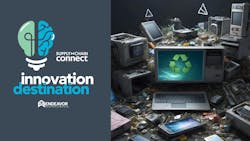Quick Chat: 8 Things You Should Know About the Growing E-Waste Problem
As a global community, we generate a lot of electronic waste, or e-waste. In fact, the United Nations Institute for Training and Research’s latest Global E-waste Monitor says the escalating e-waste problem vastly outstrips the rate at which we’re recycling those materials. Defined as any discarded product with a plug or battery, e-waste harbors toxic additives and hazardous substances that could threaten human health and environmental well-being.
According to the United Nations Institute for Training and Research, the world is experiencing “significant electronification,” including a digital transformation, with technologies profoundly changing the way we live, work, learn, socialize and do business. This growth has created a surge in the amount of waste from electrical and electronic equipment (EEE) and e-waste. The e-waste generated in 2022 contained 63 billion pounds of metals, 37 billion pounds of plastics and 31 billion pounds of other materials such as minerals, glass, and others.
Here are eight more things to know about the mounting, global e-waste problem:
- According to earth.com, the 62 million tons of e-waste generated in 2022 could fill a line of 40-ton trucks encircling the earth’s equator.
- Just 22.3% of this e-waste was documented to have been recycled properly, spotlighting the vast number of valuable resources—worth an estimated $62 billion—that remain untapped, and highlighting the increased pollution and health risks to communities across the globe.
- The annual rise of 2.6 million tons in e-waste production—with predictions set to soar to 82 million tons by 2030—"underscores a pressing need to amplify recycling endeavors to prevent further environmental degradation and safeguard human health,” earth.com states.
- Managing e-waste has become big business. DataHorizzon Research says the e-waste management market is on track to reach $207.1 billion by 2032. The market is experiencing a compound annual growth rate of 13.4% right now.
- Disposing of electronic devices carefully is necessary because they contain heavy metals that can harm the nervous system, bloodstream and vital organs. DataHorizzon Research states that, “Companies invest in e-waste management and recycling systems to achieve zero waste and reduce the use of raw materials in their manufacturing processes.”
- An estimated 42 billion pounds of e-waste, mainly from metals like iron which is present in high quantities and has high recycling rates in almost all e-waste management routes, were turned into secondary resources, according to the United Nations Institute for Training and Research’s most recent report.
- Platinum-group metals and precious metals were among the most valuable metals but present in much lower quantities; nonetheless, an estimated 661,000 pounds were turned into secondary resources through formal and informal recycling practices.
- The share of patent applications for e-waste management rose from 148 per million in 2010 to 787 per million in 2022. Most of those applications were related to technologies for cable recycling, “with hardly any signs of an increase in the number of patents filed for technologies related to critical raw materials recovery,” the United Nations Institute for Training and Research reports.
Looking ahead, Statista expects annual, global e-waste generation to hit 82 million metric tons by 2030—up from 62 million in 2022.
The company reports that, “rapidly advancing technologies, rising consumer demand for electronics and shorter product life cycles have made e-waste a growing source of environmental concern. With only 81 countries worldwide covered by electronic waste legislation, policy and regulation, increasing collection and recycling rates will be one of the biggest challenges of the coming decade.”
About the Author
Tyler Fussner
Managing Editor - Community Manager | Supply Chain Connect
Tyler Fussner is Managing Editor - Community Manager at Supply Chain Connect, part of the Design & Engineering Group at Endeavor Business Media.
Previously, Fussner served as the Associate Editor for Fleet Maintenance magazine. As part of Endeavor's Commercial Vehicle Group, his work has been published in FleetOwner magazine, as well as Bulk Transporter, Refrigerated Transporter, and Trailer-Body Builders.
Fussner's May 2022 print feature 'The dawn of hydrogen trucks' was named the best single technology article in B2B by the judges of the 2022 Folio: Eddie and Ozzie Awards. Fussner was also awarded Silver in the Technical Article category for the Trade Association Business Publications International (TABPI) 2021 Tabbie Awards.
Fussner previously served as Assistant Editor for Endeavor's Transportation Group on the PTEN, Professional Distributor, and VehicleServicePros.com brands.
Fussner studied professional writing and publishing at the University of Wisconsin-Whitewater. He has experience in shop operations, is a Michelin Certified Tire Technician, and a Michelin Certified Tire Salesperson.







